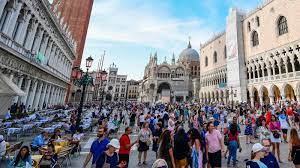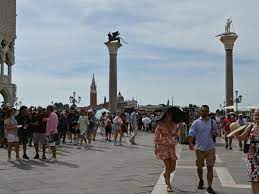Italy battles against mass tourism

Venice: As Italy prepares to welcome a record number of tourists in 2023, cities and regions such as Venice and Sardinia are introducing bans, controls and fees to try to manage the crowds. Will they work?
Tourists in Venice are expected to be on their best behavior. For years, the northern Italian city has been fighting the negative aspects of mass tourism — and as a result, strict rules for vacationers are being enforced this summer.
It’s now forbidden to walk around the city naked or to jump into the canals for a swim. Tourists had also better watch where they take a seat — sitting and lying down is prohibited on sidewalks and bridges and on the sides of fountains and stairs. Violators will be fined.
The city’s government also aims to limit the number of people entering Venice. In 2019, Venice counted 5.5 million visitors, which is 100 times the population of the city. The introduction of an entrance fee for travelers not staying the night, which was announced several years ago by the Venice city council, has yet to be put in place. It has now been postponed until 2024.

The entry fee will then be tested on a trial basis during 20 days when crowds in the city are particularly heavy, according to a city government spokesperson. “However, the matter is very complex,” he added. “The city of Venice is the first in Italy to implement this measure. We want to be sure that everything is done properly.” There is no model to follow, he pointed out.
Venice, however, is not the only place in Italy that is implementing measures in order to manage crowds of tourists.
This summer in the municipality of Baunei on Sardinia, access to some of the most sought-after beaches is being strictly regulated, as the newspaper Il Messaggero reports. There are a limited number of places per day on such beaches, which must be reserved and paid for in advance.
Italy is experiencing unprecedented numbers of vacationers this summer. According to the market research institute Demoskopika, the country will set a new tourist record in 2023. The number of visitors is expected to reach 68 million people — almost 3 million more than before the pandemic in 2019. The rush is causing problems in many places, including on the country’s smaller islands, where rental car traffic clogs streets in the summer months.

As a result, tourists are now banned from bringing their own vehicles to the islands of Lampedusa and Linosa, located between Sicily and North Africa. The same applies on the island of Procida in the Gulf of Naples.
“This is the only measure that works,” Procida mayor Raimondo Ambrosino told newspaper Il Messaggero. “We are the most densely populated island in Europe, and for us mobility is a problem.”
Every year, he said, 600,000 tourists come to the 4-square-kilometer (1.5-square-mile) island, and they mostly want to walk anyway. Cars and mopeds only cause unnecessary chaos.
This summer, access to the Pragser Wildsee lake in the Fanes-Sennes-Prags Nature Park in the northern Italian province of South Tyrol is also being controlled. You can only go there if you book a ticket online in advance, use public transport, travel by bike or walk. This is intended to limit the steadily increasing number of visitors. In addition, South Tyrol has also imposed a limit on the number of beds in tourist accommodation facilities.
In the coastal town of Portofino on the Italian Riviera, not far from Genoa, the city’s mayor has taken measures to combat overtourism.
On summer days, thousands of vacationers crowd the narrow streets around the harbor.
To prevent complete chaos from breaking out in the picturesque town, a new regulation in force this summer allows police officers to fine tourists up to €275 ($303) for “lingering” to take selfies in certain Instagram-famous areas, which are now marked as red zones or “no waiting” areas.
“The ordinance prohibits gatherings in certain areas of the borough where getting around is so difficult that police must be called in to control pedestrians,” Portofino Mayor Matteo Viacava told news portal Leggo. “This is a commonsense safety measure.” Tour operators and guides, in particular, are urged to make sure that groups of tourists do not gather in certain areas, he said.
There’s something else that’s a thorn in Mayor Viacava’s side: badly behaved tourists. For this reason, Portofino put another ordinance in effect this May, which details a series of rules of etiquette for tourists, as reported by Il Secolo XIX. In the town center, it is now forbidden to walk barefoot, in a bikini or with one’s upper body unclothed.
It’s also forbidden to sit on the stairs or on the ground. “Our goal is not to drive tourists away or discourage them from visiting,” mayor Viacava told Il Secolo XIX. “Everyone must do their part to contribute to the beauty of Portofino by behaving properly.”





